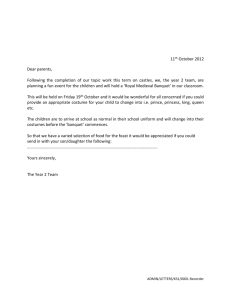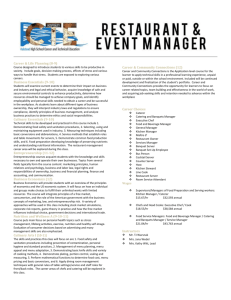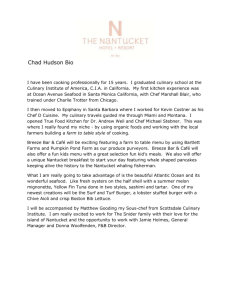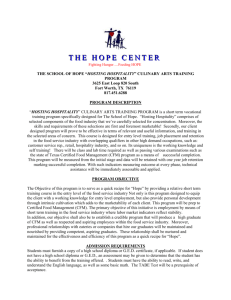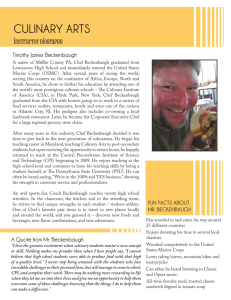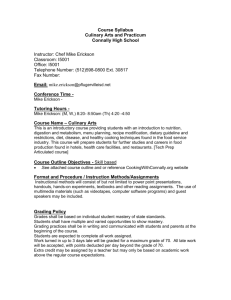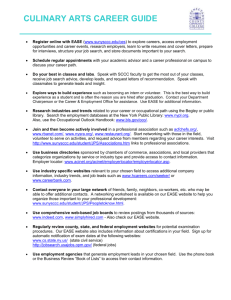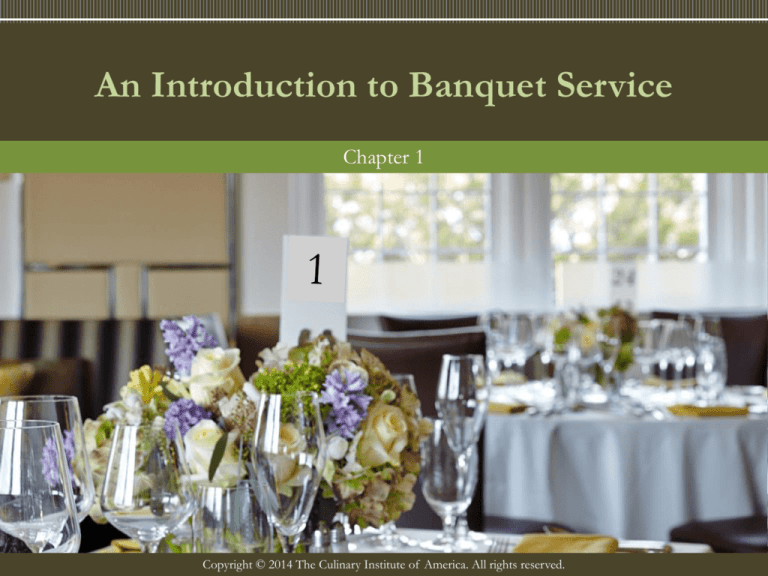
An Introduction to Banquet Service
Chapter 1
Copyright © 2014 The Culinary Institute of America. All rights reserved.
Learning Objectives
• Describe the history of banquets, from the classical period, to
the Renaissance, and through today.
• Describe the types of banquets and different styles of locations.
• Explain the banquet service team’s roles and responsibilities.
Copyright © 2014 The Culinary Institute of America. All rights reserved.
Earliest Banquets:
Greeks and Romans
• Being invited to dine signaled social recognition and said a lot
about one’s power.
• Guests dined on couches, resting on their left sides.
• The meal was divided into three courses.
• Servants brought large dishes from the kitchen and each guest
chose his favorite portion.
• The Greeks served their guests wine mixed with water.
Copyright © 2014 The Culinary Institute of America. All rights reserved.
Banquets in Medieval and
Renaissance Europe
• In the late fourteenth century, people began to think of food
and its service as art forms.
• The host would display their wide collection of silver on shelves,
known as a buffet.
• The placement of the salt cellar determined the status of diners.
– High status diners ate “above the salt,” and the rest below.
• The sequence of dishes was cold foods were warm, light foods
before heavy.
Copyright © 2014 The Culinary Institute of America. All rights reserved.
The Renaissance
• Dining and service became more elaborate, just as art and music
did.
• Cleanliness was a new focus, and tables were covered with cloths
and kept clean.
– Except for the hanging sides, which were used as napkins.
• Tables were arranged in a “U” leaving an area for entertainment.
• A brigade system was introduced, lending to pomp and protocol.
Copyright © 2014 The Culinary Institute of America. All rights reserved.
Banquets in the 1700s and 1800s
• Today’s formal service style has its roots in service à la française.
• As guests entered the dining room, the first course was already
set up.
• The French eventually took notice of service à la Russe, and
began serving items tableside.
– What was then service à la Russe is now called service à la
française.
Copyright © 2014 The Culinary Institute of America. All rights reserved.
Banquets in the Victorian
and Edwardian Eras
• Place settings included an array of crystal, fine china, and silver.
• Gloved servers carried platters and trays to guests, who would
serve themselves.
• Dishes and serviceware became more unique and extravagant.
Copyright © 2014 The Culinary Institute of America. All rights reserved.
Today’s Banquets
On-Premise
Banquet Halls
An operation that is dedicated to the catering
and service for events.
Restaurants
Many restaurants have a private area or areas
that can be used for parties.
Hotels and
Resorts
Cruise Lines
Depend on banquets to stay profitable.
Clubs
Some clubs make their banquet facilities
available only to members.
Arranged and managed as they would be in a
hotel, but with less availability of goods.
Copyright © 2014 The Culinary Institute of America. All rights reserved.
Today’s Banquets (cont’d)
Off-Premise Banquets
• All food, personnel, and
equipment must be brought
to a location.
• Transportation is a major
challenge.
• The host can find the perfect
setting, which may stimulate
creativity.
© 2014 The Culinary Institute of America
Copyright © 2014 The Culinary Institute of America. All rights reserved.
Banquet Service Teams
Office Team
• In large operations, there may be an office staff dedicated to the
sale and marketing of banquets.
– Food and beverage director: oversees purchases, sales, labor,
etc.
– Banquet salesperson: works directly with the client in
developing the menu and then creates the BEO/contract.
– Event planner: often an external position hired by the client
to work with the catering facility.
Copyright © 2014 The Culinary Institute of America. All rights reserved.
Banquet Service Teams (cont’d)
Back of House Team
• There is usually a separate group of cooks and prep people to
staff the kitchen for an event.
• Communication with the chef is critical for planning the
tabletop, renting equipment, and executing the dinner.
• The executive chef is responsible for menus, food purchases,
and food costs.
Copyright © 2014 The Culinary Institute of America. All rights reserved.
Banquet Service Teams (cont’d)
Front of House Team
Maître
d’Hôtel
Supervises the setup of the dining room and
choreographs the food and beverage service.
Captain
Manages the service of a specific section of the
dining area.
Sommelier
Will recommend specific wines to the client and serve
them with each course.
Expeditor
Functions as the quality-control person in a catering
kitchen, examining each plate before it is served.
Pantry
Person
Is in charge of organizing and coordinating items to
assist the service staff.
Copyright © 2014 The Culinary Institute of America. All rights reserved.
Banquet Service Teams (cont’d)
Ancillary Staffing for a Banquet
• Some events have more elaborate staffing needs than others.
– Valet parking: Valet parking is often needed, but it creates
liability.
– Coat check: Never leave the coat check unattended.
– Restroom attendants: Maintain the cleanliness of the
restroom.
Copyright © 2014 The Culinary Institute of America. All rights reserved.
Banquet Service Teams (cont’d)
Hotel Banquet Facility Organizational Chart
Hotel Organizational Chart for Banquets:
In some hotels, depending on the size and the number of banquets running simultaneously, the
banquet manager/salesperson may also act as Maître d’hôtel, or supervise each of the Maîtres
d’hôtel/ Head Captains in all of the events,
G.M.
Food &
Beverage
Director &
Assistant
Option
Banquet
Manager/Salesperson
Maître
d’hôtel
Banquet
Salesperson
Captains
Servers
Bartenders
Bar Backs
Exec.
Chef
Beverage
Manager
Banquet
Chef
Sous
Chef
Prep Cooks
Line Cooks
Bussers
© 2014 The Culinary Institute of America
Copyright © 2014 The Culinary Institute of America. All rights reserved.
Banquet Service Teams (cont’d)
Moderate-Size Banquet Facility Organizational Chart
Moderate Size Banquet Facility Organizational Chart
Owner
(Chef)
Beverage
Manager
Saleperson
Bartenders
Coat Check
Bar Backs
Valet Parking
Restroom
Attendants
Maître d’hôtel
Captains
Servers
Bussers
Chef
Sous Chef
Prep cooks
Line Cooks
Pot washers
Dishwashers
© 2014 The Culinary Institute of America
Copyright © 2014 The Culinary Institute of America. All rights reserved.
Stewards
Banquet Service Teams (cont’d)
Small Banquet Facility Organizational Chart
• A small catering company
may only have one or two
employees.
Small Catering Company Organizational Chart
Owner/Chef/
Salesperson
Servers
Cooks
Dish washers
© 2014 The Culinary Institute of America
Copyright © 2014 The Culinary Institute of America. All rights reserved.

